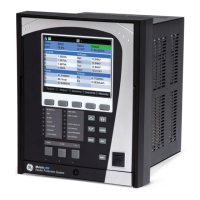CHAPTER 6: PROTECTION SETPOINTS VOLTAGE ELEMENTS
850 FEEDER PROTECTION SYSTEM – INSTRUCTION MANUAL 6–97
UV Reactive Power (27Q)
More and more distributed energy resources (DER) are fitted in the MV grid. The amount of
controllable power reserve (active and inductive reactive power) by means of large-scale
conventional plants is decreasing. Reactive power is used to maintain mains voltage
stability. Faults in the grid, increasing load with reactive power requirements and changes
within the network may lead to mains voltage drops. In the event of severe voltage drops in
several grid sections, such voltage instability may cause a collapse of the mains voltage by
means of cutting the power supply (blackout).
Protection equipment is of considerable importance for secure and reliable operation of
networks, connection facilities and generating plants. National grid codes and regulations
require that DER units feeding into MV grid must support the mains voltage of a network
failure. Therefore, the purpose of voltage and frequency protection units at machine level is
to disconnect the generating units from the grid in case of faults. If a voltage drops and an
inductive, reactive power flow in the direction towards the generating unit are detected at
the network connection point simultaneously, then the affected generating unit will be
switched off (disconnecting the generator circuit breaker).
After an unsuccessful attempt to disconnect the generating unit, the whole DER plant will
be switched off by the circuit breaker at the network connection point.
The UV Reactive Power element consists of a protection function and generating unit
restoration function.
Protection Function
UV reactive power protection function operates after a configurable time delay
(programmed as Pickup Delay) as soon as:
• all the phase voltages fall below the set voltage level, programmed as Pickup Voltage,
and the measured positive sequence current I1 exceeds the current supervision level,
programmed as Curr Superv Level, and
• the measured reactive power exceeds (when Var Direction = Reverse) the level
programmed as Pickup Vars, or falls below (when Var Direction = Forward) the Pickup
Vars.
Restoration Function
The restoration function can send the closing command to the generating unit CB (circuit
breaker) when:
• all the phase voltages are above the minimum voltage level, programmed as Min
Voltage, and
• frequency is within the minimum and maximum frequency range, programmed as
Min Frequency and Max Frequency respectively, and
• if Synch Supervision is programmed as ON, it permits the closing of the breaker by
asserting Synch 1 Close Perm operand.
The mains voltage may not necessarily have measured at the network connection point.
According to the above-mentioned protective functions, re-closing of the generator CB
shall only take place after the set time delay programmed as Restore Delay.
To the extent that the DER is disconnected from the grid at the network connection point,
the individual generating units are shut down, too. Consequently, re-closing of the CB at
the network connection point does not require any mains voltage measurement. Re-
closing is done manually.

